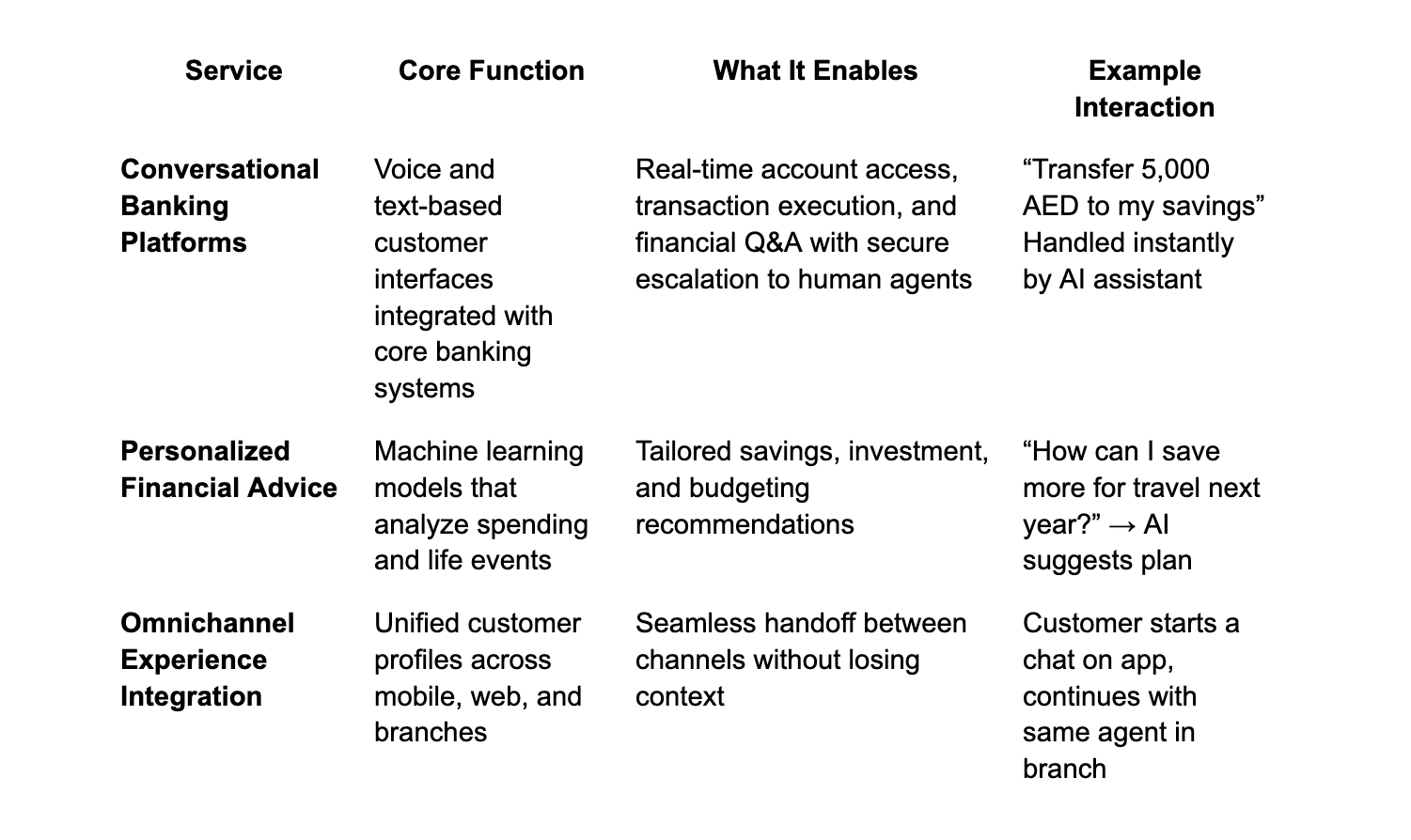The banking industry undergoes fundamental transformation through artificial intelligence implementation that enhances risk assessment, customer experiences, and operational efficiency while maintaining regulatory compliance and financial stability. Financial institutions deploy AI technologies across fraud detection, credit scoring, algorithmic trading, and customer service to improve decision-making accuracy and reduce operational costs. Industry research indicates that AI implementation in banking generates average cost reductions of 22% while improving customer satisfaction scores by 15-20%.
The integration of machine learning, natural language processing, and predictive analytics enables banks to process vast transaction volumes, identify complex fraud patterns, personalize financial products, and automate regulatory compliance processes that traditionally required extensive manual oversight and analysis.
01. Risk Management and Fraud Detection
AI applications in risk management represent the most critical implementation area for banking institutions, directly impacting financial stability, regulatory compliance, and customer protection through sophisticated pattern recognition and predictive modeling capabilities.
Advanced Fraud Detection Systems
Modern banking fraud detection requires real-time analysis of transaction patterns, customer behaviors, and external threat intelligence to identify suspicious activities while minimizing false positives that disrupt legitimate customer transactions.
- Real-Time Transaction Monitoring systems. Analyze millions of transactions simultaneously using machine learning algorithms that identify anomalous patterns indicative of fraudulent activity. These systems evaluate transaction amounts, merchant categories, geographic locations, and timing patterns against established customer baselines to detect unusual behaviors. Advanced algorithms incorporate contextual factors like device fingerprints, IP addresses, and behavioral biometrics to improve detection accuracy while reducing false positive rates.
- Behavioral Analytics platforms. Establish individual customer profiles based on spending patterns, transaction frequencies, and interaction preferences to identify deviations that may indicate account compromise. Machine learning models continuously update customer profiles as behaviors evolve naturally while flagging sudden changes that suggest unauthorized access. Behavioral analytics prove particularly effective for detecting account takeover fraud where criminals use legitimate credentials but exhibit different usage patterns.
- Network Analysis techniques. Identify fraud rings and coordinated attacks by analyzing relationships between accounts, devices, and transaction patterns. Graph neural networks map connections between seemingly unrelated accounts to uncover sophisticated fraud schemes that traditional rule-based systems cannot detect. Network analysis enables banks to identify and shut down entire fraud operations rather than responding to individual incidents.
Credit Risk Assessment and Scoring
AI-powered credit assessment transforms traditional underwriting processes through comprehensive data analysis that improves lending decisions while expanding access to credit for underserved populations.
- Alternative Data Integration. Incorporates non-traditional data sources including social media activity, utility payments, and mobile phone usage patterns to assess creditworthiness for customers with limited credit histories. Machine learning algorithms analyze these alternative data sources to identify reliable predictors of repayment behavior that complement traditional credit bureau information. Alternative data analysis enables banks to serve previously unbanked populations while maintaining appropriate risk management standards.
- Dynamic Risk Modeling. Updates credit scores and risk assessments continuously based on changing customer circumstances, market conditions, and payment behaviors. Traditional credit scores provide static snapshots that may not reflect current customer situations, while dynamic models incorporate real-time data to provide more accurate risk assessments. Dynamic modeling enables banks to adjust credit limits, interest rates, and product offerings based on current risk profiles rather than historical assessments.
- Portfolio Risk Management. Uses AI to optimize loan portfolio composition and identify concentration risks across different customer segments, geographic regions, and economic sectors. Machine learning models analyze correlations between different risk factors to predict portfolio performance under various economic scenarios. Portfolio optimization algorithms balance risk and return objectives while ensuring compliance with regulatory capital requirements and risk management policies.
Regulatory Compliance and Anti-Money Laundering
Banking institutions face complex regulatory requirements that demand sophisticated monitoring and reporting capabilities to detect money laundering, terrorist financing, and other illicit activities.
Transaction Pattern Analysis identifies suspicious transaction patterns that may indicate money laundering activities through analysis of transaction flows, timing patterns, and counterparty relationships. AI systems analyze transaction networks to identify structuring, layering, and integration patterns characteristic of money laundering schemes. Advanced pattern recognition algorithms adapt to evolving money laundering techniques while maintaining compliance with regulatory reporting requirements.
Customer Due Diligence automation streamlines know-your-customer processes through automated identity verification, risk assessment, and ongoing monitoring. Natural language processing systems analyze customer documentation, news articles, and regulatory databases to identify potential risks and compliance issues. Automated due diligence reduces manual effort while improving consistency and accuracy of customer risk assessments.
Regulatory Reporting automation generates required compliance reports through automated data collection, validation, and formatting that ensures accuracy and timeliness. AI systems monitor regulatory changes and update reporting processes automatically to maintain compliance with evolving requirements. Automated reporting reduces compliance costs while minimizing the risk of regulatory violations and associated penalties.
02. CX & Digital Banking
AI transformation in customer-facing operations enables banks to deliver personalized experiences, reduce service costs, and improve customer satisfaction through intelligent automation and data-driven insights.
Intelligent Customer Service
Banking customer service operations require sophisticated AI systems that can handle complex financial inquiries while maintaining security and regulatory compliance standards.

Conversational Banking Platforms provide natural language interfaces that enable customers to perform banking transactions, check account balances, and receive financial advice through voice and text interactions. These systems integrate with core banking systems to provide real-time account information while maintaining appropriate security controls. Advanced conversational AI handles complex queries about loan applications, investment options, and financial planning while escalating specialized requests to human advisors.
Personalized Financial Advice systems analyze customer financial data, spending patterns, and life events to provide customized recommendations for savings, investments, and financial planning. Machine learning algorithms identify opportunities for customers to optimize their financial situations through product recommendations, spending adjustments, and investment strategies. Personalized advice systems increase customer engagement while generating additional revenue through product cross-selling and upselling.
Omnichannel Experience Integration ensures consistent customer experiences across mobile apps, websites, call centers, and branch locations through unified customer profiles and interaction histories. AI systems maintain context across different channels so customers can start interactions on one platform and continue on another without repeating information. Omnichannel integration improves customer satisfaction while reducing service costs through more efficient interaction management.
Digital Onboarding and Account Management
AI streamlines customer acquisition and account management processes through automated verification, risk assessment, and product recommendation systems.
Automated Identity Verification uses biometric analysis, document verification, and behavioral authentication to confirm customer identities during account opening processes. Computer vision systems analyze identity documents for authenticity while facial recognition technology matches photos to live video feeds. Automated verification reduces onboarding time from days to minutes while maintaining security standards and regulatory compliance.
Risk-Based Authentication adapts security requirements based on transaction risk levels, customer behaviors, and contextual factors to balance security with user experience. Machine learning algorithms analyze login patterns, device characteristics, and transaction histories to determine appropriate authentication requirements. Low-risk transactions may require minimal authentication while high-risk activities trigger additional verification steps.
Product Recommendation Engines analyze customer financial profiles, life stages, and usage patterns to suggest relevant banking products and services. AI algorithms identify customers who would benefit from specific products like mortgages, investment accounts, or business banking services based on their financial situations and behaviors. Intelligent recommendations increase product adoption rates while providing customers with services that meet their actual needs.
Wealth Management and Investment Services
AI applications in wealth management provide sophisticated investment analysis, portfolio optimization, and financial planning capabilities that were previously available only to high-net-worth clients.
- Robo-Advisory Platforms. Provide automated investment management services through algorithmic portfolio construction, rebalancing, and tax optimization. Machine learning algorithms analyze market conditions, customer risk tolerance, and investment objectives to create and maintain diversified portfolios. Robo-advisors democratize professional investment management while reducing costs and minimum investment requirements.
- Market Analysis and Research automation. Uses natural language processing to analyze financial news, earnings reports, and market research to generate investment insights and recommendations. AI systems process vast amounts of financial information to identify trends, risks, and opportunities that inform investment decisions. Automated research capabilities provide comprehensive market analysis while reducing the time and cost of traditional research processes.
- Portfolio Risk Management systems. Continuously monitor investment portfolios for risk exposures, concentration issues, and performance deviations from target allocations. Machine learning algorithms analyze correlations between different assets and market factors to predict portfolio performance under various scenarios. Risk management systems automatically rebalance portfolios and adjust allocations to maintain target risk levels and investment objectives.
Operations Impact & Process Automation 03
AI implementation across banking operations generates significant efficiency improvements and cost reductions through process automation, document processing, and intelligent decision-making systems.
Document Processing and Automation
Banking operations involve extensive document processing for loan applications, compliance reporting, and customer communications that benefit from AI-powered automation.
- Intelligent Document Processing extracts relevant information from loan applications, financial statements, and legal documents through optical character recognition and natural language processing. AI systems identify key data points, validate information accuracy, and route documents to appropriate processing workflows automatically. Automated document processing reduces manual effort by 70-80% while improving accuracy and processing speed.
- Contract Analysis automation reviews loan agreements, vendor contracts, and regulatory documents to identify key terms, compliance requirements, and potential risks. Natural language processing systems analyze contract language to extract important clauses, deadlines, and obligations while flagging unusual or problematic terms. Automated contract analysis accelerates legal review processes while ensuring consistency and completeness.
- Regulatory Documentation automation generates required compliance reports, audit documentation, and regulatory filings through automated data collection and formatting. AI systems monitor regulatory requirements and automatically update documentation processes to maintain compliance with changing regulations. Automated documentation reduces compliance costs while minimizing the risk of regulatory violations.
Back-Office Operations Optimization
AI applications in back-office operations streamline transaction processing, reconciliation, and settlement processes that form the foundation of banking operations.
Trade Settlement Automation uses AI to match trades, verify settlement instructions, and identify discrepancies in securities transactions. Machine learning algorithms analyze trade data to predict settlement failures and automatically resolve common issues before they impact settlement timelines. Automated settlement processing reduces operational risk while improving efficiency and cost-effectiveness.
Reconciliation Process Automation matches transactions across different systems and identifies discrepancies that require investigation and resolution. AI systems analyze transaction patterns to predict and prevent reconciliation breaks while automatically resolving routine discrepancies. Automated reconciliation reduces manual effort and improves accuracy while accelerating month-end and quarter-end closing processes.
Liquidity Management optimization uses AI to predict cash flows, optimize funding costs, and maintain appropriate liquidity levels across different currencies and time horizons. Machine learning algorithms analyze historical patterns, market conditions, and business forecasts to optimize liquidity management decisions. Intelligent liquidity management reduces funding costs while ensuring compliance with regulatory requirements.
Algorithmic Trading and Market Making
AI applications in trading operations provide sophisticated market analysis, execution optimization, and risk management capabilities that improve trading performance while managing market risks.
High-Frequency Trading systems use machine learning algorithms to identify short-term market inefficiencies and execute trades at microsecond speeds. These systems analyze market microstructure, order flow patterns, and price movements to identify profitable trading opportunities. High-frequency trading requires sophisticated risk management systems to prevent significant losses from algorithmic errors or market disruptions.
Market Making Algorithms provide liquidity in financial markets through intelligent bid-ask spread management and inventory optimization. AI systems analyze market conditions, volatility patterns, and order flow to optimize market making strategies that balance profitability with risk management. Algorithmic market making improves market liquidity while generating consistent trading revenues.
Portfolio Execution optimization uses AI to minimize market impact and transaction costs when executing large orders across multiple markets and time periods. Machine learning algorithms analyze market conditions, liquidity patterns, and price movements to optimize execution strategies. Intelligent execution reduces trading costs while minimizing market impact for large institutional transactions
04. Regulation & Compliance
Banking institutions face increasingly complex regulatory environments that require sophisticated technology solutions to ensure compliance while maintaining operational efficiency and customer service quality.
Automated Compliance Monitoring
Regulatory compliance requires continuous monitoring of transactions, communications, and business activities to identify potential violations and ensure adherence to banking regulations.
- Real-Time Compliance Monitoring systems analyze transactions, communications, and trading activities continuously to identify potential regulatory violations as they occur. Machine learning algorithms learn from historical violations and regulatory guidance to improve detection accuracy while reducing false positives. Real-time monitoring enables immediate corrective action to prevent regulatory violations and associated penalties.
- Communication Surveillance uses natural language processing to monitor employee communications for potential misconduct, insider trading, and regulatory violations. AI systems analyze emails, chat messages, and recorded phone calls to identify suspicious language patterns and inappropriate communications. Communication surveillance helps banks maintain ethical standards while ensuring compliance with conduct regulations.
- Model Risk Management ensures that AI and machine learning models used in banking operations meet regulatory standards for accuracy, fairness, and transparency. Model governance frameworks include validation processes, performance monitoring, and bias testing that ensure models operate within acceptable risk parameters. Effective model risk management prevents regulatory violations while maintaining the benefits of AI implementation.
Stress Testing and Scenario Analysis
Banking regulators require comprehensive stress testing to ensure financial institutions can withstand adverse economic conditions and market disruptions.
Automated Stress Testing uses AI to simulate various economic scenarios and assess their impact on bank capital, liquidity, and profitability. Machine learning algorithms analyze historical data and economic relationships to generate realistic stress scenarios that test bank resilience. Automated stress testing improves the accuracy and comprehensiveness of regulatory stress tests while reducing manual effort.
Scenario Generation creates diverse economic scenarios that capture potential risks and market disruptions that could impact banking operations. AI systems analyze economic data, market relationships, and historical patterns to generate plausible scenarios for stress testing and risk management. Comprehensive scenario analysis helps banks prepare for various potential challenges while meeting regulatory requirements.
Capital Planning optimization uses AI to determine optimal capital allocation strategies that balance regulatory requirements with business objectives and shareholder returns. Machine learning algorithms analyze business forecasts, regulatory requirements, and market conditions to optimize capital planning decisions. Intelligent capital planning ensures regulatory compliance while maximizing return on equity and supporting business growth.
Future Directions and Emerging Technologies
The banking industry continues evolving through emerging AI technologies and new application areas that create additional opportunities for innovation and competitive differentiation while introducing new risks and regulatory challenges.
Advanced AI Technologies
Next-generation AI capabilities including quantum computing, and federated learning create new possibilities for banking applications while requiring updated risk management and governance frameworks. The Quantum Computing Applications promise significant improvements in optimization problems, cryptography, and risk modeling that could transform banking operations. Quantum algorithms may revolutionize portfolio optimization, fraud detection, and cryptographic security while requiring new infrastructure and expertise. Banks invest in quantum research and partnerships to prepare for future quantum computing capabilities.
On the other hand, Federated Learning will enable collaborative AI model development across multiple banks while preserving data privacy and competitive advantages. Federated learning allows banks to improve fraud detection and risk models through shared learning without sharing sensitive customer data. This approach enables industry-wide improvements in AI capabilities while maintaining data security and competitive positioning.


